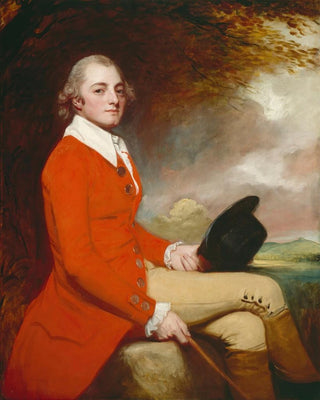Art print | Thomas Grove de Ferne, Wiltshire - George Romney


View from behind

Frame (optional)
Reproduction Thomas Grove de Ferne, Wiltshire - George Romney – Engaging Introduction
In the rich and diverse landscape of British art history, the artwork "Thomas Grove de Ferne, Wiltshire" by George Romney stands out for its elegance and psychological depth. Painted at the end of the 18th century, this piece not only showcases the undeniable talent of the artist but also reflects the social and cultural atmosphere of its time. Through the portrait of Thomas Grove, Romney manages to capture the very essence of his subject, blending intimacy and grandeur, while offering a fascinating glimpse into English aristocratic life. This painting, both intimate and majestic, invites contemplation that transcends mere observation, engaging the viewer in a reflection on identity and social status.
Style and uniqueness of the work
George Romney's style is characterized by remarkable finesse in rendering textures and expressions. In "Thomas Grove de Ferne, Wiltshire," he employs a palette of soft, nuanced colors, creating a warm atmosphere that envelops the viewer. The treatment of lights and shadows, a hallmark of his approach, gives an almost sculptural dimension to Grove's face, highlighting his features with a delicacy that demonstrates Romney's technical skill. The subject's posture, slightly turned, suggests a lively dynamism, while the background, subtly blurred, emphasizes the central figure without overpowering it. This artwork thus distinguishes itself through its ability to establish a dialogue between the subject and the environment, a characteristic that echoes the artistic sensibility of its era.
The artist and his influence
George Romney, born in 1734 in Dalton-in-Furness, is one of the most prominent portraitists of his time. His artistic journey, marked by various influences, notably those of neoclassical painting and rococo, shaped his unique style. Romney successfully established himself in the London art scene, attracting an aristocratic clientele eager to have their portraits rendered with such mastery. His innovative approach to portraiture, blending realism and idealization, inspired many contemporary and future artists. Through iconic works like "Thomas Grove de Ferne"

Matte finish

View from behind

Frame (optional)
Reproduction Thomas Grove de Ferne, Wiltshire - George Romney – Engaging Introduction
In the rich and diverse landscape of British art history, the artwork "Thomas Grove de Ferne, Wiltshire" by George Romney stands out for its elegance and psychological depth. Painted at the end of the 18th century, this piece not only showcases the undeniable talent of the artist but also reflects the social and cultural atmosphere of its time. Through the portrait of Thomas Grove, Romney manages to capture the very essence of his subject, blending intimacy and grandeur, while offering a fascinating glimpse into English aristocratic life. This painting, both intimate and majestic, invites contemplation that transcends mere observation, engaging the viewer in a reflection on identity and social status.
Style and uniqueness of the work
George Romney's style is characterized by remarkable finesse in rendering textures and expressions. In "Thomas Grove de Ferne, Wiltshire," he employs a palette of soft, nuanced colors, creating a warm atmosphere that envelops the viewer. The treatment of lights and shadows, a hallmark of his approach, gives an almost sculptural dimension to Grove's face, highlighting his features with a delicacy that demonstrates Romney's technical skill. The subject's posture, slightly turned, suggests a lively dynamism, while the background, subtly blurred, emphasizes the central figure without overpowering it. This artwork thus distinguishes itself through its ability to establish a dialogue between the subject and the environment, a characteristic that echoes the artistic sensibility of its era.
The artist and his influence
George Romney, born in 1734 in Dalton-in-Furness, is one of the most prominent portraitists of his time. His artistic journey, marked by various influences, notably those of neoclassical painting and rococo, shaped his unique style. Romney successfully established himself in the London art scene, attracting an aristocratic clientele eager to have their portraits rendered with such mastery. His innovative approach to portraiture, blending realism and idealization, inspired many contemporary and future artists. Through iconic works like "Thomas Grove de Ferne"






